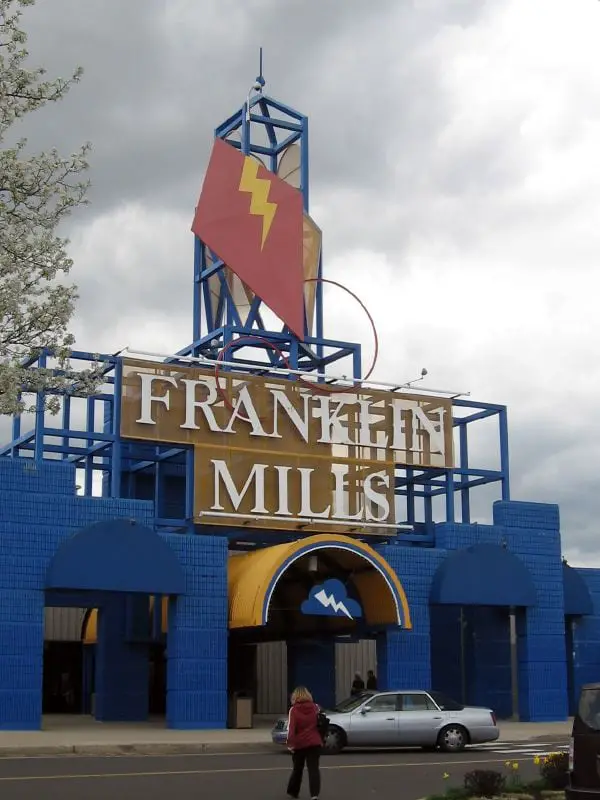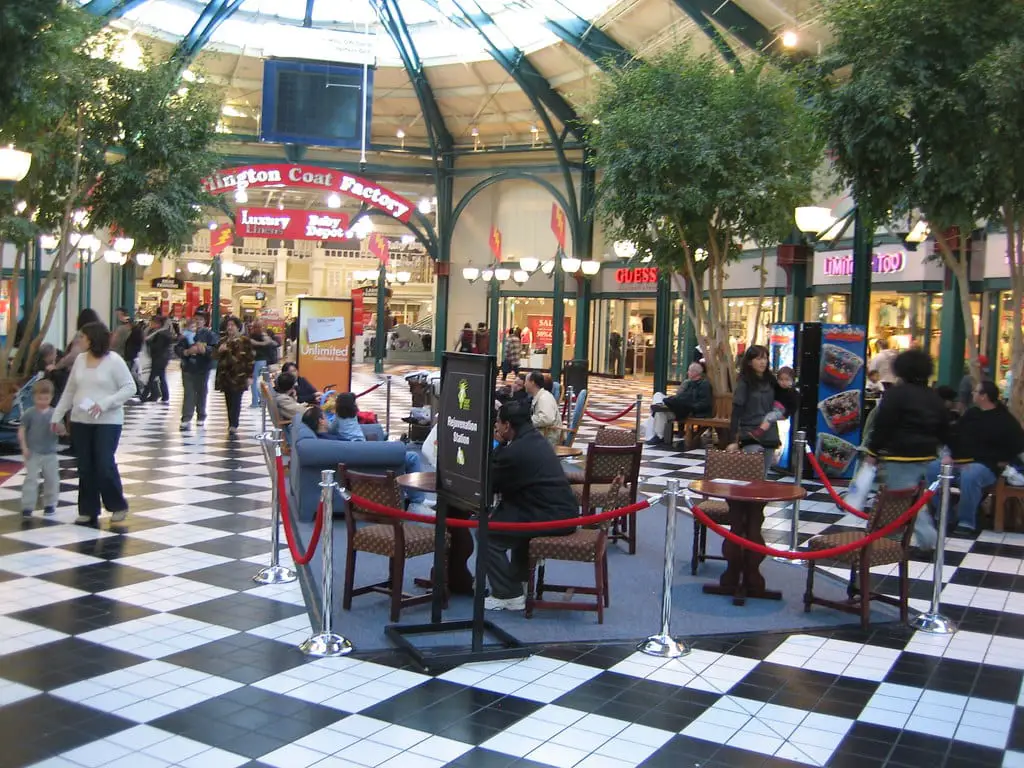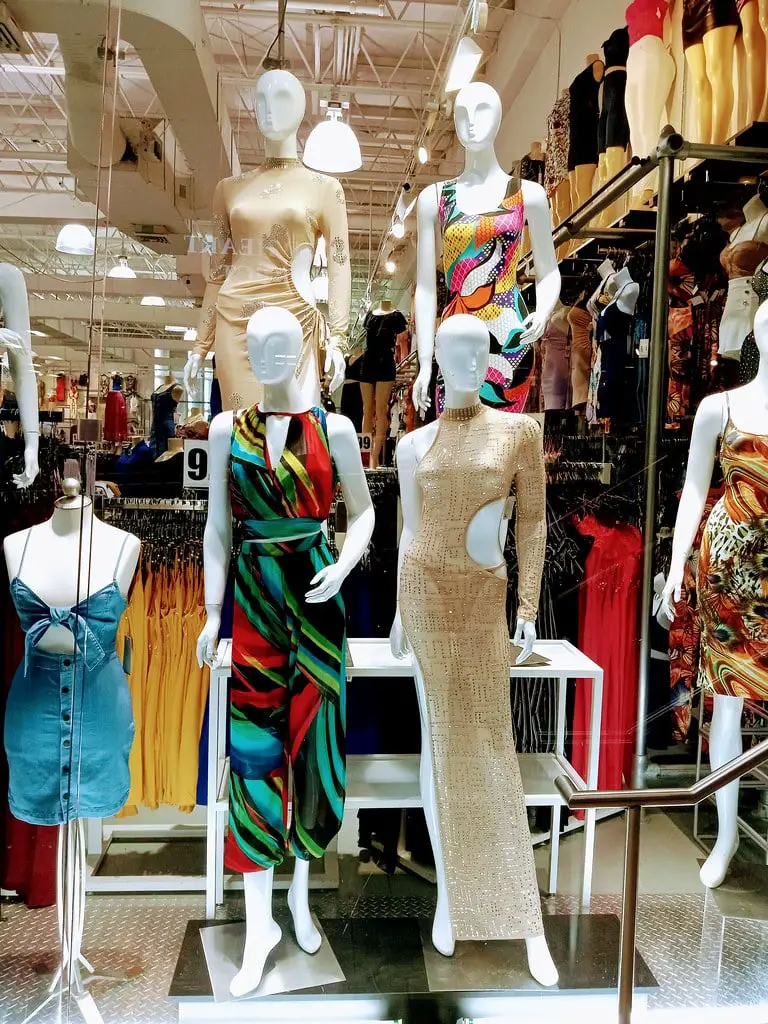Origins and Early Years
Franklin Mills Mall occupies the former Liberty Bell Park Racetrack site in Northeast Philadelphia. In the mid-1980s, the Mills Corporation purchased the racetrack land and began developing the mall. Construction started in 1988, with the grand opening on May 11, 1989.
The original layout included anchor stores such as Sears, JCPenney, Phar-Mor, Reading China and Glass, and Ports of the World, which were crucial in drawing visitors. The mall quickly became known for its factory outlet stores, which offered discounted merchandise from various well-known brands.
Franklin Mills was designed with a unique layout resembling a thunderbolt, commemorating Benjamin Franklin’s famous kite experiment. Early marketing efforts highlighted the mall’s extensive retail space and diverse store offerings.
From its opening through the 1990s, Franklin Mills attracted millions of shoppers annually. It featured popular stores like Toys “R” Us, K•B Toy Works, and Everything’s A Dollar, making it a go-to destination for shopping and entertainment in Philadelphia.
The mall’s early success set the stage for its development as one of Pennsylvania’s largest retail centers, frequently mentioned in lists of things to do in Philadelphia, PA.
Layout and Design
Franklin Mills’ design stood out from other malls. Its thunderbolt shape gave it a unique appeal.
The mall was divided into four neighborhoods: Red, Yellow, Blue, and Green. Each section offered different stores and themes, making shopping feel like an adventure.
The Red Neighborhood included major stores like Marshalls and Burlington and housed the “Cafe Court,” one of the mall’s two food courts.
The Blue Neighborhood featured electronics and entertainment stores, while the Yellow Neighborhood had fashion and accessories outlets.
The Green Neighborhood, home to the larger “Cafe Freedom” food court, hosted various outlet stores and dining options.
Franklin Mills had multiple entrances, each marked by colors corresponding to the neighborhoods. This layout helped visitors navigate the expansive space.
The mall also featured unique architectural elements, like its high ceilings and wide corridors, designed to enhance the shopping experience.
One of my favorite features was the animatronic likeness of Benjamin Franklin in the Grand Court. It announced the time hourly, adding a touch of historical charm.
The mall’s design aimed to offer more than just shopping; it provided an experience, blending retail with thematic elements.

Ownership and Management Changes
The Mills Corporation initially developed and managed Franklin Mills. The mall thrived under their management throughout the 1990s. However, economic shifts and changes in retail trends started affecting the mall’s performance.
In 2007, Simon Property Group acquired Franklin Mills. Simon, a major player in the retail property market, already managed the King of Prussia Mall. Their acquisition brought new management strategies and changes.
On September 16, 2014, Simon renamed the mall from Franklin Mills to Philadelphia Mills, aiming to refresh its brand and attract more visitors.
Despite these efforts, the mall struggled to maintain its earlier success. Changes in consumer behavior, crime, the rise of online shopping, and economic downturns impacted foot traffic.
Simon Property Group introduced various initiatives to revitalize the mall, including renovations and new store openings. However, the challenges of the retail environment persisted.
The ownership and management changes reflected broader trends in the retail industry. Malls across the country faced similar issues, with many trying to adapt to a rapidly changing market.
Franklin Mills’ story mirrors the struggles and strategies of many large retail centers.
Decline and Store Closures
Franklin Mills started seeing a downturn in the early 2000s. Anchor stores, which were once the main attractions, began to leave.
JCPenney closed its outlet store in the mall as part of a nationwide realignment. Sears Outlet also left, only to return later, taking over OfficeMax’s space. The shifting tenants created an unstable retail environment.
The mall also saw a wave of closures among smaller stores. Retailers like Steve’s Comic Relief, Everything’s A Dollar, and Hooters shut down, leaving many storefronts empty and reducing the mall’s appeal.

By 2014, the rebranding to Philadelphia Mills aimed to revive interest but didn’t fully stop the decline.
The COVID-19 pandemic dealt another blow to the mall, temporarily shutting it down and leading to further declining foot traffic.
The vacancy rate climbed. In 2024, many mall areas are empty. Some standing anchor stores include Marshalls, Burlington, TURN 7, and Walmart.
Despite attempts to attract new businesses, the retail landscape changes rapidly, making recovery difficult.
Crime and Incidents
Franklin Mills faced several security issues over the years. In late 2016, a violent flash mob incident occurred.
Around 30 teenagers started fights in the food court, attacking a police officer. This led to heightened security concerns and a perception of the mall as unsafe.
In 2020, during the George Floyd protests, looting threats emerged. Police surrounded the mall to prevent any looting or raids.
This incident highlighted the challenges of maintaining safety and security in a large retail space.
Early 2021 saw two shootings within the mall. On February 7, a 21-year-old man was shot in the neck. The cause was unclear, but it resulted in a security lockdown.
A more tragic event occurred on March 29, when a fight in the food court led to a fatal shooting. The stepson of a local detective was killed, further damaging the mall’s reputation.
These incidents underscored the mall’s struggles beyond economic challenges. Safety issues drove away customers and contributed to the declining foot traffic.
The once vibrant shopping center became associated with crime, complicating efforts to revitalize and restore its former glory.

Recent Developments
Philadelphia Mills, despite its decline, has seen some recent changes. Simon Property Group initiated several renovations to revitalize the mall.
They updated the Red, Green, and Orange entrances to give them a modern look, aiming to attract new tenants and visitors.
The planned Marriott hotel, announced in mid-2023, will be a notable addition to the area. It will be near the mall.
The project hopes to draw more visitors and boost the local economy. The hotel is part of a broader strategy to transform the surrounding space and make it more appealing.
One notable event is the reopening of the Franklin Mills Flea Market. Starting on April 7, 2024, the flea market operates every Sunday, attracting visitors with various vendors and unique finds.
This event aims to bring more foot traffic to the mall and provide a platform for local businesses.
The Future of Franklin Mills
Looking ahead, Philadelphia Mills’s future is uncertain. The high vacancy rate and past incidents have damaged its reputation.
Efforts to revitalize the mall, such as the Marriott hotel and renovations, show a commitment to rejuvenating the area.
The mall’s management needs to address safety concerns. Ensuring a secure shopping environment is crucial for attracting visitors.
Improved security will make restoring customer confidence and increasing foot traffic easier.

Innovative retail concepts and events could help breathe new life into the mall. Pop-up shops, local markets, and entertainment events might attract diverse crowds.
These initiatives can create a vibrant atmosphere and make the mall a community hub.
Ultimately, Philadelphia Mills must adapt to survive. The retail landscape has changed, and traditional malls must innovate to stay relevant.
With strategic planning and investment, the mall has the potential to come back. Its history shows that it can draw crowds; the challenge lies in reinventing itself for the future.
